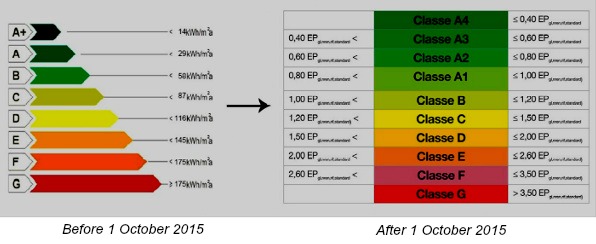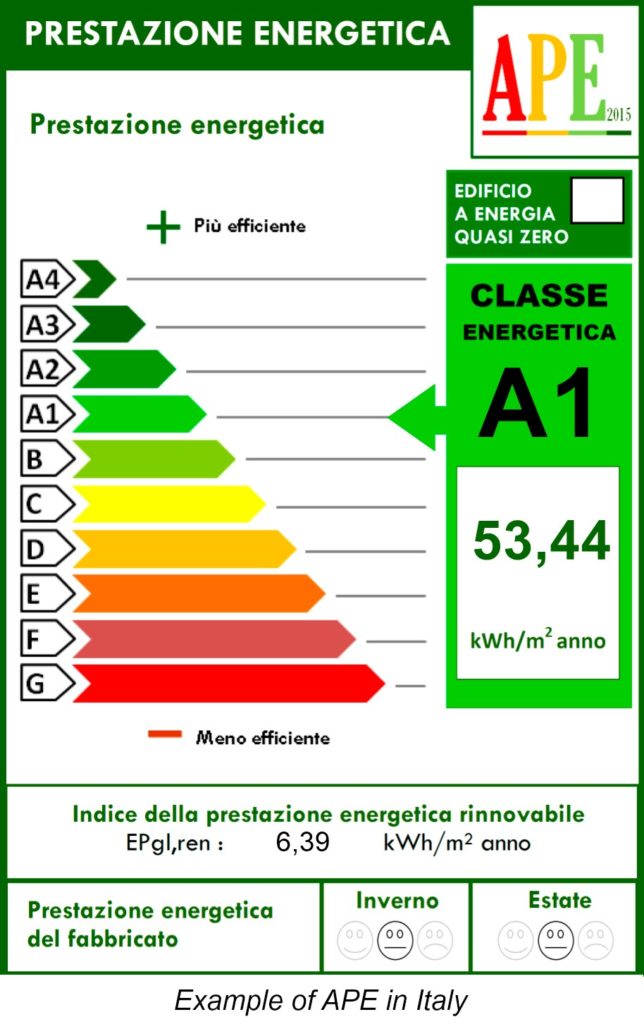While searching for your dream home in Italy, how many of you have ever asked yourselves about the exact meaning of those “strange acronyms, letters and numbers” appearing in many real estate ads on Gate-away.com, as well as in many other websites?
They represent the energy efficiency level of a building. Okay, maybe you already knew it… but what is their purpose and how to interpret them? The issue could become a bit more complicated.
We will try to explain it with the help of Andrea Salcone from “Design? Studio Associato”, engineer and energy efficiency expert.
1. Why is the energy efficiency level of a property listed in a real estate ad?
“Energy performance certification of buildings in Italy was introduced following recent European directives aimed at reducing energy consumption in the states belonging to the EU and at introducing the “energy efficiency” parameter, a new criterion in the property market. So since 1 January 2012 it is mandatory to provide each building with the energy performance certificate, called APE in Italy, when a home is put for sale or for rent.”
2. What is exactly an Energy Performance Certificate (APE)?
“The APE is a very important document for potential home buyers and people looking to rent a property as it provides information concerning energy consumption in buildings and recommendations on where you could make improvements. It also includes data on winter and summer air conditioning systems, hot water production for sanitary uses and ventilation. Furthermore it analyses the ability of walls and floors that separate a heated room from the outside or from unheated rooms to retain the heat within the building.
That is why in any property advert – even if regarding a property for sale without any heating system, such as beach houses, historic homes or properties without a boiler – one must show the energy class and the energy efficiency value, both listed in the APE.
Starting from 1 October 2015 the new APE has replaced the former certificate, so that now each building is assigned a specific energy class represented by a scale of 10 levels ranging from A4 (the most efficient), A3, A2, A1, B, C, D, E, F to G (the least efficient). On the contrary, before 1 October 2015 the letters used were A+, A, B, C, D, E, F, G.
In any case certificates following the former method and issued until the end of September 2015 are still valid for 10 years from the date of issue as long as in the meanwhile the building has not been altered so a new certificate will be required. So we are in a transition period in which new and former energy performance certificates are not directly comparable.”
3. Can you tell us how to read house energy ratings in a real estate advert?

“As you will notice, in property ads the energy class is represented by an alphanumeric value where the letter A is the most energy efficient (lower energy consumption), while the letter G the least (highest energy consumption). House energy ratings, as it happens with household electrical appliances, help you to determine the best “products”, namely the property with highest building standards in terms of consumption. This means that the higher the class (e.g. A), the more economic it is to keep a comfortable environment inside the house.”

“The energy class scale is not fixed, but is established based on the global energy performance index value “EP” (primary energy) of a “reference building”. What does that mean? That every building for which an APE is issued it is evaluated by means of the comparison of its performance with that of its “reference building”, that is an identical building in geometrical terms (surface, volumes, location, orientation, end use, etc.) but with “standardised” walls, fixtures and systems, comparable to that which our building would have if should it be built today with insulated building structures and systems of the same type, but with insulation and performance typical of the actual equipment.
For this reason the energy class alone does not supply sufficient information to compare two different buildings, because their “reference buildings” used for the calculation will also be different, and therefore “the scale” deriving from that.
In fact, the energy class is supplied also with a numeric value which gives the measurement of the building’s energy consumption, and perhaps this is the parameter to which we should pay more attention.”
4. In what sense is the numeric value of the rating the most important parameter? Why should we be more concerned with that?
“Well, the value of the energy efficiency rating (EPgl,nren) gives us the numeric value, under reference conditions, of the building’s energy consumption and refers to the consumption of non-renewable energy sources, like the gas used for heating the building or producing hot water.
The rating is expressed in kWh/m² per year and indicates the kilo-wattage of energy required by the building under standard conditions for every year and every square metre of floor-space heated. This value can be translated into money once the energy source used, and the cost of it, have been defined.”
5. But how do we manage to compare the consumption of two different buildings and choose the one which will see us spend less from an energy point of view?

“Let’s do a practical example!
Suppose you are interested in buying a 100 m² property with energy efficiency rating of 53.44 kWh/m² per year and uses a natural gas condensing boiler.
Now to make the calculation simple, but still indicative overlooking some technical details, let’s consider that 1 m³ of natural gas is equivalent to about 38 MJ (megajoules), that is approximately 10 kWh, and on average is sold to us at € 1.
>> Then the property in question will require for heating and hot water production 53.44 kWh/m2 x 100 m2 = 5.344 kWh.
At this point we can easily calculate the m³ of gas we will need: 5.344 kWh ÷ 10 kWh/m3 = 535 m3 which at 1.00 €/m³ will therefore cost us € 535 per year.
The real value though will differ based on our habits (temperature set on the thermostat, amount of hot water used, etc.) and on periods with anomalous weather conditions, but normally it will not move too much from our hypothesis.
A similar thing can be said on changing the energy source, or its price, obtaining different costs, but the initial parameter for the calculation is always the numeric value of the energy efficiency index, which undoubtedly represents one of the most important pieces of information contained in the APE.”
6. When is the APE required?
“By law there are specific cases in which APE is mandatory. Here are the main examples:
- You are renting your home out for more than 30 days
- You are writing a house advertisement for the property (for sale or for rent)
- You want to sell a new building
- You are planning to renovate your property and this will impact its energy performances
- You are going to donate your property (free of charge sale)
In addition, the APE certificate must be attached to all sale and lease agreements. Also, it is necessary in case you are entitled to claim tax deductions for having carried out renovation works.
It is obligatory to draw up a new certificate every 10 years, or before in case of renovation works which alter the heat capacity or the structure of the building (e.g., replacing the boiler, flooring, doors, windows, etc.).”
7. Are there any cases in which APE certificate is not necessary?
“Yes, of course there are. Here are some main circumstances:
- Isolated buildings measuring less than 50 m²
- Properties in need of completion with no doors and windows, finishes and technological systems
- Cellars, car boxes, garages, warehouses
- Non-residential rural or farm buildings which are not equipped with heating/air conditioning systems
- Ruins”
8. How is an APE produced in Italy?
“It is issued after inspection by an accredited and qualified technician specialised in the design of buildings and systems, such as engineer, surveyor or architect, whose training, supervision and accreditation is handled by Regions according to specific local laws. He will inspect walls, doors, windows and existing systems, and with the help of nationally certified softwares he will evaluate the energy efficiency quality of the property in order to issue the APE.”
9. And how much does an APE cost?
“The cost of the certificate is not fixed and is not subject to a minimum price. Approximately, the average cost can range from a minimum of € 80 to a maximum of € 300/400, depending on the city, the size of the house and the technician who performs the inspection, the accuracy of the method used by the expert carrying out the inspection. In case you need this certificate, it is advisable to ask for a quote in advance and check that it includes all expenditure items for an APE which will be legally valid in order to avoid unpleasant surprises.”

Andrea Salcone is an expert engineer specialized in several fields including energy efficiency, environmental sustainability and energy saving; heating, ventilation and air conditioning (HVAC); environmental and building acoustics, and fire safety engineering. Based in Le Marche region, he works with a team of qualified technicians and skilled engineers and can offer design and consulting services both in Italian and English.










